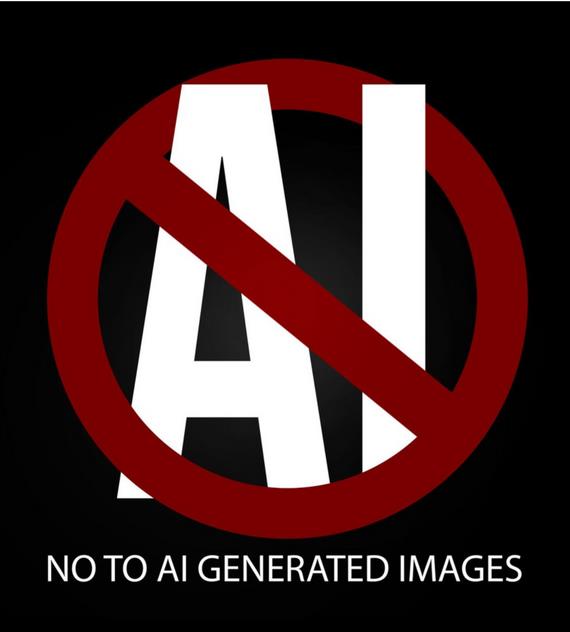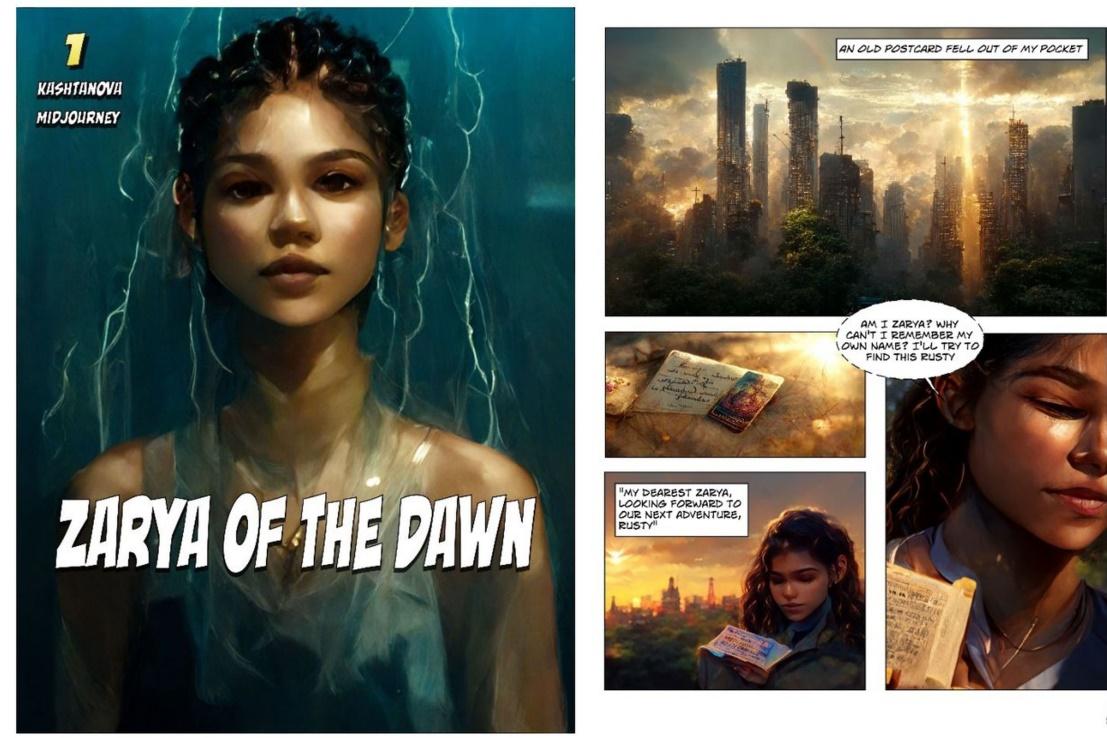Today we are witnessing the rapid advancement of artificial intelligence (AI) technologies which are capable of generating human-like images, audio, and text.1 While many people are excited by these AI technologies, these advancements have also rung the warning bell for many individuals in creative industries who believe that AI technologies are exploiting their work and harming their profession as a whole. This is especially a concern for the art industry
Recently, AI technologies which generate images have become increasingly sophisticated. These AI technologies are programmed to learn how to generate images from scraping publicly accessible data – in this case images – from the internet.2 Consequently, artists are becoming concerned about how their artwork online is being exploited by large companies to train their AI to create new works, often for a profit.
Last year, artists around the world took to the internet and reposted images of a red prohibition circle over the letters “AI” in protest of image-generating AI. The first person to post this image appears to be an artist named Alexander Nanichtkov who stated in a tweet that “AI creates the ‘art’ you see on the backs of artists being exploited . . . AI ‘art’ is currently scraping the web for art and uses it in datasets. No artist gave consent to have their art used. We were not compensated.” 3 In the face of these concerns, many legal professionals are currently considering the extent to which intellectual property rights – particularly copyrights – serve to protect the work of artists.

A variation of the symbol posted in protest of AI generated art.4
Under the Copyright Act, copyright protection is only granted to “original works of authorship.” 5While there is no law or provision of the United States Constitution which defines who may be considered an “author,” the UnitedStates Copyright Office (USCO) tends to only recognize copyrights for works “created by a human being.” 6 Courts actually have a history of denying copyright protection to non-human authors. For instance, in Naruto v. Slater the Ninth Circuit Court of Appeals held that Naruto, a crested macaque, did not have legal standing to claim copyright infringement under the Copyright Act for pictures that Naruto took 7 himself. And for those wondering, Naruto’s claims were filed by the People for the Ethical Treatment of Animals (PETA).8
Beyond the context of copyright protection for animals, courts have also considered cases regarding copyright protection for AI systems.This past April, the Supreme Court declined to hear an appeal from a computer scientist named Stephen Thaler, who filed a suit to claim a copyright on behalf of hisAI system, known as Device for Autonomous Bootstrapping of Unified Sentience (DABUS).9 Although Thaler argued that DABUS created the works autonomously, the Court upheld the decision of the lower courts and the USCO, and declined his appeal “on the grounds that the AI couldn’t be considered the legal creator of those works.” While these decisions may seem promising to human artists since they deny copyright protection to non-human authors, the issue of AI generating images is far from settled.
The U.S. Patent and Trademark Office acknowledges when these AI technologies scrape data from the internet to generate images, this process “will almost by definition involve the reproduction of entire works or substantial portions thereof,”10 and as a result, copyright infringement seems quite plausible. In fact, a recent decision by the USCO has ruled that AI generated works – whether that is art, writing, or music – will not be granted copyright protection. 11 This decision arose from a copyright application for a comic called Zarya of the Dawn, which used original writing alongside art generated by Midjourney, an AI program.12 In their letter to Zarya creator Kristina Kashtanova, the USCO explained how “the office will not register works produced by a machine or mere mechanical intervention from a human author” and how the crucial question is “whether the ‘work’ is basically one of human authorship, with the computer . . .merely being an assisting instrument, or whether the traditional elements of authorship in the work . . . were actually conceived and executed not by man but by a machine.” 13

The cover page and second page of Zarya of the Dawn14
On the other hand, OpenAI, a company that uses AI generating tools, has argued that the works created by AI tools should be protected since they qualify as fair use since the process of scraping data from the internet is done to “create a useful generative AI system and the copies aren’t made available to the public.” 15 To provide another recent example, this past February Getty Images sued Stability AI alleging that it “copied at least 12 copyrighted images from Getty Images’websites” to train their Stable Diffusion AI program.16 While Stability AI responded with a fair use defense, Getty argues that this defense is inapplicable since Stability AI’s AIprogram undermines the market for Getty’s copyrighted material. At the same time, Stability AI is also facing a class action lawsuit from several artists alleging copyright infringement due to the use of their images to train their AI programs.
AI image-generating tools have also caused controversies since they can scrape data to mimic a particular artist’s style.This past January, DeviantArt – an online art website – was sued for copyright infringement after they began offering a new service in which users could pay a monthly subscription to access an AI art generator.17 This AI art generator was trained on the artwork of artists who uploaded their art to DeviantArt for free,and users could enter a text prompt to generate images.18 Furthermore, users of this AI tool could even input a specific artist’s name in order to create an image which replicated that exact artist’s style.19 The claim argues that this constitutes copying and consequently breaches copyright. 20 While this may seem like a clearcase of copyright infringement, not everyone in the legal community agrees. For example, Andres Guadamuz, a legal school at the University of Sussex, believes that these AI tools are simply learning patterns from the original works, brushstrokes, and styles which are not covered by copyright law.21
To add another layer of complexity to this matter, the USCO has stated that an AI-generated work could be copyrightable if an individual can prove that “they themselves put a meaningful amount of creative effort into the final content.” 22 In other words, while a company that uses an AI system, which scrapes images from the internet to produce new content, may be found to have committed copyright infringement, if that company can prove they added ameaningful amount of creative effort to the final product, then the company could actually argue that they have a valid copyright in the new work.23 This would overcome the previous problem that individuals have faced when they tried to make an AI system a copyright holder.
This does not mean however, that minimal contributions made to an AI-generated work would automatically qualify for copyright protection. The Director of the USCO Shira Perlmutter stated “If a work’s traditional elements of authorship were produced by a machine, the work lacks human authorship and theOffice will not register it.”24 For example, if an AI system produced a work solely based on a human prompt then the “’traditional elements of authorship’ are determined and executed by the technology – not the human user.”25 On the other hand, if an AI-system produced a work of art based on a human prompt,and then that finished work was then edited further using Photoshop, the USCO has stated that a copyright is more likely to be granted.26
This new stance on the copyrightability of AI-generated works brings with it a wide array of new problems. For example,there is no definitive standard or test which could be used to determine whether a company or individual has made a meaningful enough contribution to an AI-generated work which would qualify it for copyright protection. As previously mentioned, the Director of the USCO Shira Perlmutter stated that if a meaningful human contribution is made to an AI-generated image, through Photoshop for example, then the AI-generated work could qualify for copyright protection.However, there would need to be further clarification or case law on how much Photoshop editing would be required to qualify as a meaningful contribution to the work. Companies could quickly make contributions to an AI-generated work on Photoshop and as a result they could defeat copyright infringement claims.This would be especially harmful to artists whose original works are used without their consent to train these AI systems which then create new works fora profit. Additionally, these new works created by AI systems could be sold at a far cheaper price since producing them is drastically quicker than the cost of human artists creating original works. This could lead to severe economic harms to human artists and could have even greater implications for theart industry as a whole.
Despite the bleakness of this situation, there may be a light at the end of the tunnel which could prevent generative-AI from gettingout of hand and inflicting severe harm on human creators. One popular method which has been discussed to control the rapid growth of generative-AI is theimplementation of some sort of licensing system.27 This type of licensing system would require companies using generative-AI to pay copyright holders a fee forusing their works in training their AI systems. This licensing system could offset some of the harm caused by generative-AI since human artists could refuse to license their original works, or they could at least be compensated for allowing their work to be used to train an AI system. Unfortunately, this licensing systemmay not address the greater problem of unfair competition between generative-AI and human artists since companies could produce new works at a far quicker and cheaper rate than human artists creating original works.
Due to the recent advancement of AI technologies and their benefits, it is likely that generative-AI systems will continue to be used for the foreseeable future. Furthermore, since these AI technologies are very new, our laws and courts are not fully prepared to handle the quickevolution of these new technologies. As a result, the consequences and effects of generative-AI systems must be continually considered since they can pose substantial harm to human artists.
1 Eric Revell, AI complicates copyright law, YAHOO! FINANCE (May 19, 2023), https://finance.yahoo.com/news/ai-complicates-copyright-law-131932670.html.
2Id.
3 Butlerian Jihad, ARTISTS MASS PROTEST AGAINST AI STEALING THEIR WORK BY SHARING ANTI-AI LOGO, THE_BYTE (Dec. 16, 2022),. https://futurism.com/the-byte/artists-protest-ai
4Verity Babbs, Digital Artists Are Pushing Back Against AI, HYPERALLERGIC (Mar. 6, 2023), https://hyperallergic.com/806026/digital-artists-are-pushing-back-against-ai/.
5 17 U.S.C. § 102
6Revell, supra note 1.
7Naruto v. Slater, 888 F.3d 418, 426 (9th Cir. 2018).
8Revell, supra note 1.
9Id.
10Id.
11 Sam Sachs, US Copyright Office Rules AI-generated artwork, content not legally protected, WFLA (Feb. 23, 2023, 2:30 PM),https://www.wfla.com/news/national/us-copyright-office-rules-ai-generated-artwork-content-not-legally-protected/.
12Id.
13Id.
14Richard Lawler, The US Copyright Office says you can’t copyright Midjourney AI-generated images, THE VERGE (Feb. 22, 2023, 9:06 PM),https://www.theverge.com/2023/2/22/23611278/midjourney-ai-copyright-office-kristina-kashtanova.
15Id.
16Id.
17 Darian Woods & Adrian Ma, AI-generated images breach copyright law, artists say, NPR (Feb. 7, 2023), https://www.npr.org/2023/02/07/1155185861/ai-generated-images-breach-copyright-law-artists-say.
18Id.
19Id.
20Id.
21Id.
22Katyanna Quach, AI-generated art can be copyrighted, say US officials – with a catch, THE REGISTER (Mar. 16, 2023), https://www.theregister.com/2023/03/16/ai_art_copyright_usco/.
23Id.
24Id.
25Id.
26Id.
27Kai Nicol-Schwarz & Tim Smith, Why Harry Potter is the copyright timebomb under generative AI models, SIFTED (May 18, 2023), https://sifted.eu/articles/generative-ai-copyright.
